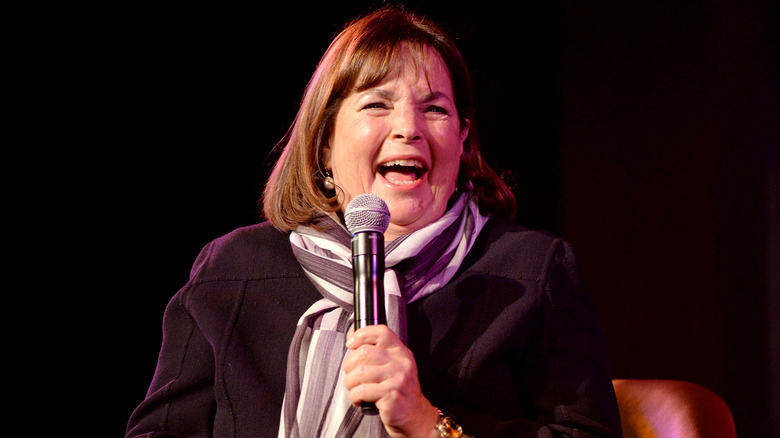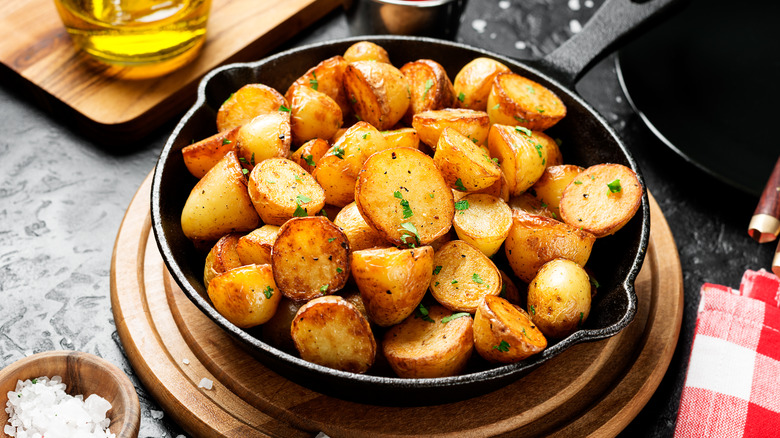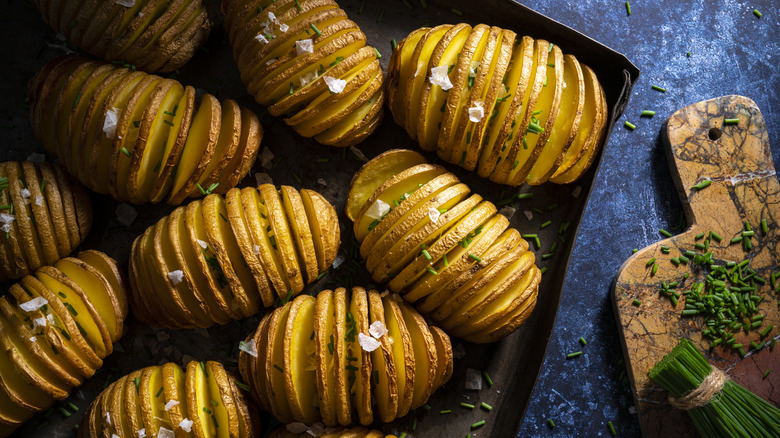Why Ina Garten Uses Both Oil And Butter For Crispy Potatoes
We may receive a commission on purchases made from links.
Crispy potato dishes come in many varieties, shapes, and sizes, from simply roasted or sauteed to crispy Spanish-style patatas bravas. However you prefer them, the crunchiness of the potatoes' exterior combined with a light, fluffy center is what makes them so satisfying to eat. And the cooking method is key — especially when it comes to which oil or fat to use for the best results.
For extra-crispy potatoes that are also packed with flavor, Ina Garten has a top tip: Use a mixture of both oil and butter. The reason, according to her "Cook Like a Pro" cookbook, is that combining both oil and butter means you get the best out of both ingredients. While oil means you can cook at higher temperatures for extra crispiness (thanks to its higher smoke point), the addition of butter lends more depth of flavor to the finished dish.
And though the Barefoot Contessa's tip is for her thinly sliced potato galette recipe, the advice can also be applied to other types of crispy potatoes. It's all about the marriage of oil and butter, which work together to elevate both the taste and texture.
Oil and butter's smoke points mean better potatoes
Different types of oil and cooking fats have different smoke points, which refers to the temperature they can be heated to before they start to break down, burn, and produce smoke. So when it comes to pan-frying potatoes, as with Ina Garten's galette, you'll want to look for the best high-heat oils for a perfect saute.
Garten uses canola oil, which has a smoke point of 400 degrees Fahrenheit, for her recipe. Other oils, such as refined olive or sunflower oils have an even higher smoke point, of 465 and 440 degrees Fahrenheit respectively. Butter, meanwhile, has a lower smoke point of around 350 degrees Fahrenheit, which makes it less versatile when cooking and crisping at higher temperatures. But what it does bring to the table is flavor — and lots of it.
When combined, the oil and butter provide a crisp, golden crust to the potatoes, as well as the rich, luxurious flavor of butter. Ina Garten starts by sauteing her thinly sliced potatoes in oil when making her galette, before adding room-temperature unsalted butter for the final few minutes. But depending on the type of crispy potato dish you're making, you can use a combination of oil and butter in a variety of different ways.
Use oil and butter for crispier roast or pan-fried potatoes
Roast potatoes are a classic side dish for any occasion, and it's that combination of crispy outsides and soft centers that makes them so utterly delicious and versatile. Using both oil and butter can help you achieve that perfect textural contrast, as well as infuse the potatoes with extra flavor. Just pre-heat a sheet pan of oil in a hot oven while you simmer some peeled diced potatoes in hot salted water for a few minutes, and then add some butter to the pan before gently tossing the potatoes (once drained and dry) in the mixture. All you have to do next is roast them until golden.
To skip the simmering part altogether and make things even easier, smaller cubes of potatoes can simply be tossed in oil, and then roasted in a pan of melted butter for an equally crisp result. Or drizzle sliced hasselback potatoes with oil and melted butter before roasting for an elegant side.
Alternatively, try pan-frying thin slices of potato in a mixture of oil and butter in a hot skillet for a crisp exterior and tender, creamy interior. Or for crispy country potatoes, boil the small cubes briefly in salt water before drying them and frying them in oil and butter. Because whether you choose to cook your potatoes on the hob or in the oven, using both fats is the secret to getting them extra crispy and packed with deliciously deep flavors.



